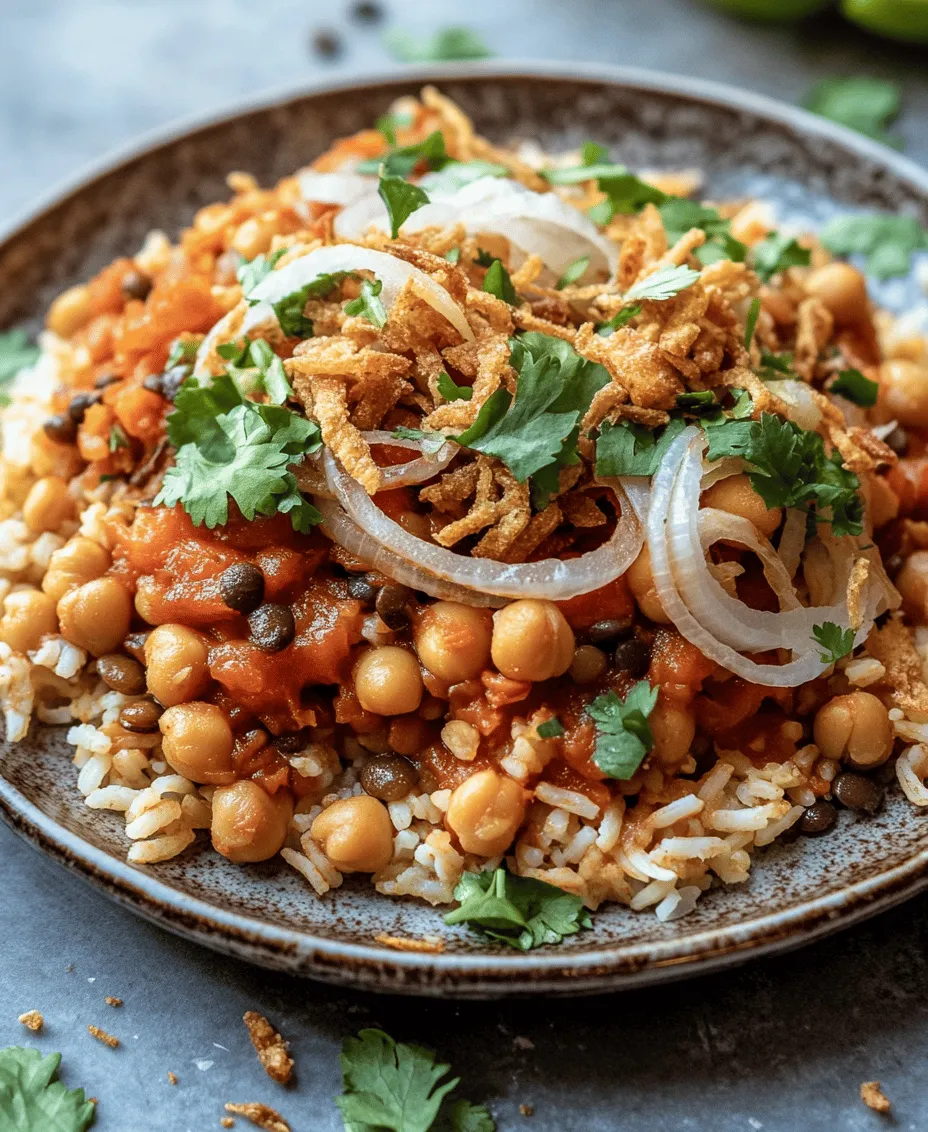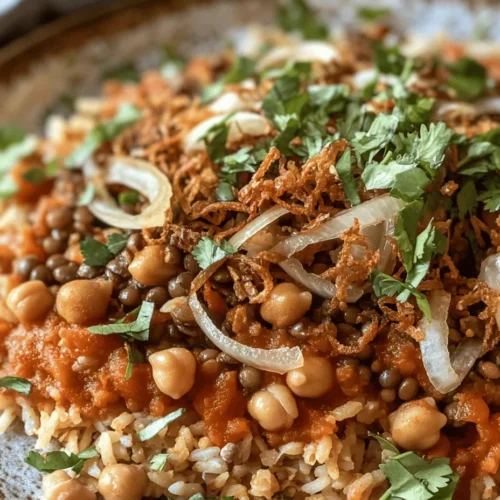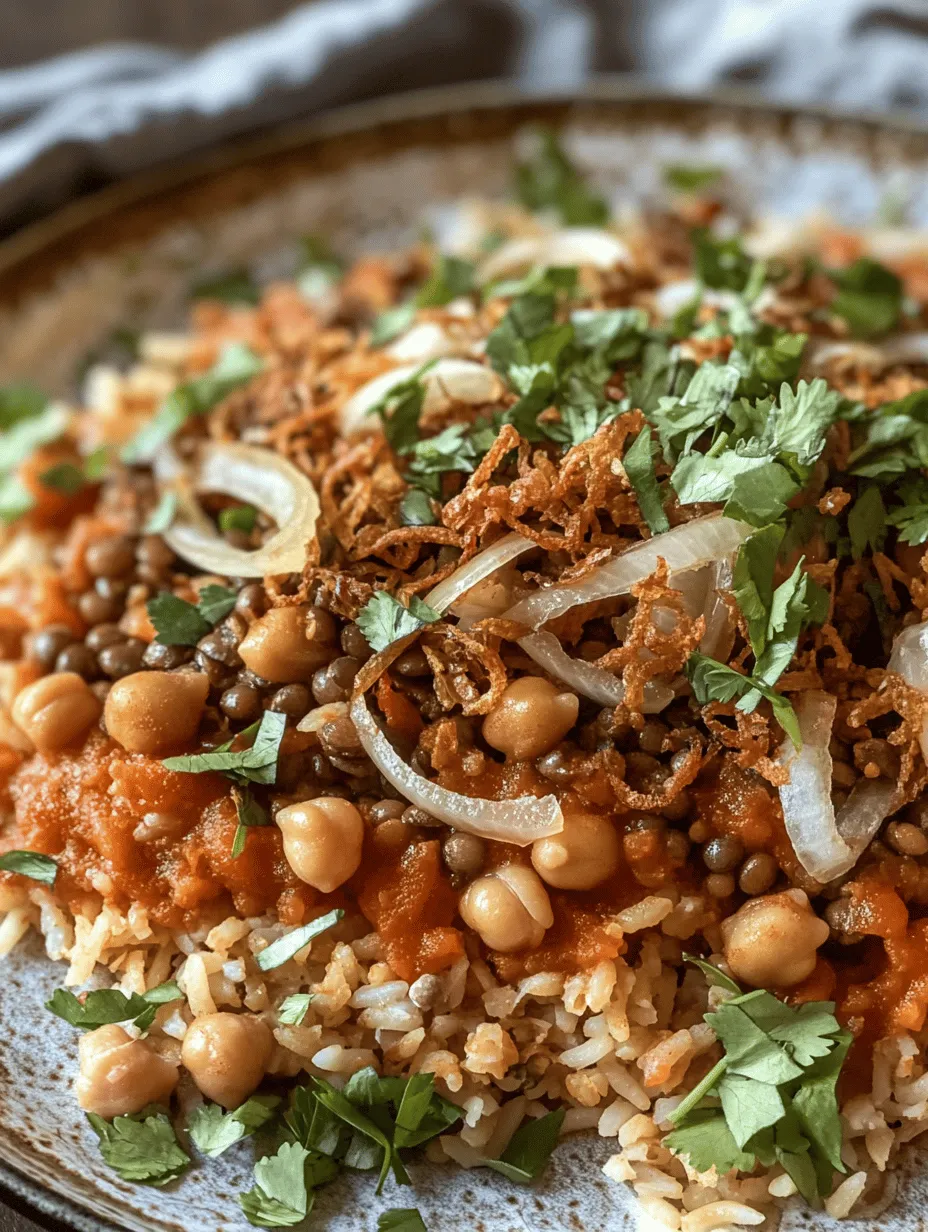Introduction
Koshari is more than just a dish; it’s a symbol of Egyptian culinary heritage, a hearty and satisfying meal that brings comfort to many. Revered as the national dish of Egypt, Koshari embodies the spirit of Egyptian street food, reflecting the country’s rich history and diverse culture. This beloved meal combines a variety of ingredients, creating a harmonious blend of flavors and textures that appeal to a wide range of dietary preferences, from vegans to meat-lovers alike.
The beauty of Koshari lies in its versatility. It can be served as a quick street-side snack or a family feast, making it a staple in many Egyptian households and restaurants. As you dive deeper into the preparation of Koshari, you’ll discover how this dish has transcended its humble beginnings to become a staple that evokes nostalgia for the flavors of home.
Understanding Koshari: The National Dish of Egypt
Historical Background of Koshari and Its Origins
Koshari’s roots can be traced back to the late 19th century, when it first emerged as a popular dish among the working class in Egypt. The dish is believed to have been influenced by various culinary traditions, including Italian and Indian, as it combines rice, lentils, and pasta—a trio not typically found in traditional Middle Eastern cuisine. Initially, Koshari was a simple meal made from leftovers, but it quickly gained popularity due to its comforting nature and affordability.
Over the years, Koshari evolved from a humble street food into a beloved national treasure, symbolizing the spirit of Egyptian hospitality. Today, it is celebrated not only for its taste but also for its ability to bring people together, making it a common choice for gatherings and celebrations.
Significance of Koshari in Egyptian Street Food Culture
Koshari is an integral part of the vibrant street food culture in Egypt. Found in bustling markets and along busy streets, vendors serve this dish in steaming portions, often garnished with a drizzle of spicy tomato sauce and a sprinkle of crispy fried onions. Its accessibility and affordability make it a favorite among locals and tourists alike.
Eating Koshari is not just about satisfying hunger; it’s an experience that connects people to the heartbeat of Egyptian life. Many Egyptians have fond memories of enjoying Koshari from street-side vendors, where the aroma of spices fills the air and the lively chatter of patrons creates a vibrant atmosphere. This communal aspect of dining elevates Koshari from mere sustenance to a cherished cultural ritual.
Common Variations and Regional Adaptations of the Dish
While the classic Koshari recipe remains beloved, various regional adaptations have emerged over the years. Some areas may add additional ingredients such as fried eggplant or a side of grilled meat. Additionally, the spice blends can vary, with some chefs incorporating local spices to infuse their unique twist into the dish.
In Cairo, for example, you might find a spicier rendition of Koshari, while in Alexandria, the dish may feature a milder sauce. Each variation tells a story of regional tastes, showcasing Egypt’s rich culinary diversity. Regardless of the variation, Koshari remains a dish that resonates with Egyptians across the nation, each with their own special memories tied to it.
Ingredients Breakdown: What Makes Koshari Unique
Overview of the Main Ingredients and Their Roles in the Dish
The magic of Koshari lies in its simple yet flavorful ingredients. Each component plays a vital role in achieving the dish’s signature taste and texture. Below, we’ll break down the essential ingredients that make Koshari a delightful culinary experience.
Lentils: Nutritional Benefits and Types Used in Koshari
Lentils are the heart of Koshari, providing a rich source of protein and fiber. The most commonly used variety in Koshari is the brown lentil, which holds its shape well during cooking and adds an earthy flavor to the dish. Rich in nutrients, lentils are not only a staple in Egyptian cuisine but also a healthy choice for anyone looking to incorporate plant-based proteins into their diet.
When cooked, lentils contribute a creamy texture that complements the other ingredients, making each bite satisfying and wholesome. Moreover, they are quick to cook, allowing Koshari to be prepared relatively easily.
Rice: Importance of Using Short-Grain Rice for Texture
The rice used in Koshari is typically short-grain, which lends a sticky texture that helps bind the dish together. Short-grain rice absorbs flavors well and provides a soft, comforting base for the other ingredients. Achieving the perfect rice is crucial, as it forms the foundation of the dish.
For optimal results, rinse the rice thoroughly before cooking to remove excess starch, which can lead to gummy rice. The right cooking method is also essential; using the correct water-to-rice ratio is key to ensuring the rice is fluffy and well-cooked.
Pasta: How Small Pasta Shapes Contribute to the Dish’s Integrity
In Koshari, small pasta shapes like ditalini or elbow macaroni are commonly used. These pasta pieces add a delightful chewiness and help create a well-rounded texture in the dish. The pasta absorbs the flavors of the tomato sauce and spices, enhancing the overall taste profile of Koshari.
Incorporating pasta into Koshari may seem unusual at first, but it is this unique combination of ingredients that sets the dish apart from other rice and lentil recipes. The pasta not only adds variety but also makes the dish more filling, ensuring that it can satisfy even the heartiest appetites.
Onions: The Role of Crispy Fried Onions in Flavor and Presentation
No Koshari is complete without the crowning glory of crispy fried onions. These golden-brown, crunchy morsels add a burst of flavor and texture to the dish, balancing the softness of the lentils, rice, and pasta. The sweet and savory notes of the fried onions elevate Koshari, making it an unforgettable culinary experience.
Frying the onions to perfection is an art in itself. They should be cooked slowly over medium heat to achieve that perfect golden color without burning. Once fried, they can be heaped on top of the Koshari, creating an inviting presentation that tempts the taste buds.
Tomato Sauce: The Base of the Dish and Its Seasoning
A rich and flavorful tomato sauce is essential for Koshari, serving as the dish’s foundation. The sauce is typically made with fresh tomatoes, garlic, and a blend of spices, including cumin and coriander, which are hallmarks of Egyptian cuisine.
This sauce not only adds moisture to the dish but also infuses each component with a burst of flavor. The balance of acidity from the tomatoes and the warmth of the spices create a perfect harmony that enhances the overall taste of Koshari.
Chickpeas: Adding Protein and Texture
Chickpeas are another vital ingredient in Koshari, contributing both protein and texture. They add a creamy element to the dish and complement the other components beautifully. Cooked chickpeas can be added directly into the mix or served on top, allowing diners to enjoy their nutty flavor in every bite.
Rich in fiber and protein, chickpeas not only enhance the nutritional profile of Koshari but also provide a satisfying crunch that contrasts with the softness of the rice and lentils.
Spices: An Exploration of Cumin, Paprika, and Coriander in Egyptian Cooking
Spices are the heart and soul of Koshari, with cumin, paprika, and coriander being the most prominent. Cumin adds a warm, earthy flavor that is unmistakably Egyptian, while paprika contributes a touch of sweetness and color. Coriander brings a hint of citrus, balancing the richness of the other ingredients.
These spices work together to create a depth of flavor that is both comforting and intriguing. The combination of these spices is essential for achieving the authentic taste of Koshari, and it’s worth experimenting with the ratios to find your perfect blend.
Optional Hot Sauce: Enhancing Flavors for Spice Lovers
For those who enjoy a kick of heat, a drizzle of hot sauce is a common addition to Koshari. The spice adds a zesty contrast to the rich flavors, making each bite even more exhilarating. Many Egyptians have their preferred hot sauce, often made from chili peppers and vinegar, which can be added according to individual taste.
Offering hot sauce on the side allows everyone to customize their Koshari experience, whether they prefer a mild or fiery version of this dish.
Step-by-Step Instructions: Crafting the Perfect Koshari
Crafting the perfect Koshari requires attention to detail and a love for the process. Here’s how to prepare this iconic dish, step by step.
1. Prepare the Ingredients: Start by gathering all your ingredients. Rinse the rice and lentils separately and soak the chickpeas overnight if using dried ones. If you’re using canned chickpeas, rinse and drain them well.
2. Cook the Lentils: In a medium pot, add the rinsed lentils and enough water to cover them by about an inch. Bring to a boil and then reduce the heat to simmer. Cook the lentils until they are tender but not mushy, about 15-20 minutes. Drain and set aside.
3. Cook the Rice: In a separate pot, add the rinsed rice and double the amount of water. Bring to a boil, then reduce the heat, cover, and simmer until the rice is cooked and the water is absorbed, about 15-18 minutes. Fluff with a fork and set aside.
4. Cook the Pasta: In a pot of boiling salted water, cook the pasta until al dente. Drain and set aside.
5. Prepare the Tomato Sauce: In a saucepan, heat some oil over medium heat. Add minced garlic and sauté until fragrant. Add crushed tomatoes, cumin, paprika, and salt, stirring to combine. Let the sauce simmer for about 15-20 minutes, allowing the flavors to meld.
6. Fry the Onions: In a frying pan, heat oil over medium heat. Slice the onions thinly and fry them until they are golden brown and crispy. Remove from oil and drain on paper towels.
7. Assemble the Koshari: In a large serving dish or individual bowls, layer the rice, followed by the lentils, pasta, and chickpeas. Drizzle with the tomato sauce and top with crispy fried onions. Serve hot with optional hot sauce on the side.
Enjoying homemade Koshari is not just about the flavors but also about the joy of preparing a dish that holds a special place in the hearts of many. With every bite, you’re not only tasting Egypt but also participating in a tradition that has stood the test of time.

Preparing the Lentils: Tips for Cooking to the Right Texture
When it comes to Koshari, the lentils are a crucial component that provides both texture and nutrition. To achieve the perfect lentils, it’s important to use the right variety—brown or black lentils are typically preferred for their ability to hold their shape. Here are some tips for cooking lentils to the right texture:
1. Rinse Thoroughly: Begin by rinsing the lentils under cold water to remove any dust or debris. This step is essential for achieving clean-tasting lentils.
2. Soak for Better Results: While soaking lentils isn’t mandatory, it can help reduce cooking time and enhance their digestibility. Soak them in water for about 30 minutes to an hour before cooking.
3. Cooking Method: In a pot, combine the rinsed lentils with water in a ratio of about 1:3 (one part lentils to three parts water). Bring it to a boil, then reduce to a simmer. Cook for approximately 20-25 minutes until tender but not mushy. Taste as you go to ensure they reach your desired texture.
4. Seasoning: Add salt only after the lentils are cooked. Adding salt too early can make them tough. A dash of olive oil or a bay leaf during cooking can enhance the flavor.
Cooking the Rice: Techniques for Perfect Fluffy Rice
Rice is another critical element of Koshari. To ensure your rice is fluffy and not sticky, follow these steps:
1. Choose the Right Rice: Long-grain rice, such as Egyptian rice or basmati, works best for Koshari due to its ability to remain fluffy when cooked.
2. Rinse the Rice: Just like lentils, rinse the rice under cold water to remove excess starch. This step is crucial for preventing the rice from clumping together.
3. Toasting for Flavor: In a saucepan, heat a tablespoon of oil and toast the rinsed rice for a couple of minutes. This not only adds flavor but also helps the rice remain separate during cooking.
4. Cooking Ratio: Use a 1:2 ratio of rice to water. For every cup of rice, add two cups of water. Bring it to a boil, then reduce the heat to low, cover, and simmer for 15-20 minutes. Avoid lifting the lid during cooking to ensure even steaming.
5. Resting Time: After cooking, let the rice sit covered for an additional 5-10 minutes. Fluff it with a fork before serving to maintain its fluffy texture.
Boiling the Pasta: Timing and Water Salting for Optimal Results
The pasta in Koshari adds a delightful texture and heartiness to the dish. Here’s how to boil the pasta perfectly:
1. Choose Small Pasta: Traditionally, small pasta shapes like elbow macaroni or ditalini are used. These shapes blend well with the other ingredients.
2. Salt the Water: Use a generous amount of salt in the boiling water—this is your chance to season the pasta. Aim for about 1-2 tablespoons of salt per gallon of water.
3. Cooking Time: Boil the pasta according to package instructions, usually around 7-10 minutes, until al dente. Stir occasionally to prevent sticking.
4. Draining: Once cooked, drain the pasta and rinse it briefly under cold water to stop the cooking process. This will help keep the pasta from becoming gummy.
Making the Tomato Sauce: Balancing Flavors and Spices
The tomato sauce is the heart of Koshari, bringing all the flavors together. Here’s how to make a deliciously balanced sauce:
1. Ingredients: Start with canned crushed tomatoes for ease, along with onion, garlic, cumin, coriander, and chili powder for spice. Fresh herbs like coriander or parsley can be added for freshness.
2. Sautéing Aromatics: In a saucepan, heat a couple of tablespoons of oil. Sauté diced onions until translucent, then add minced garlic and cook until fragrant.
3. Building the Sauce: Add the crushed tomatoes to the pan along with the spices. Stir well, and let it simmer for about 15-20 minutes. Adjust the seasoning with salt, pepper, and sugar to balance the acidity of the tomatoes.
4. Taste and Adjust: The sauce should be rich and flavorful. Taste it as it cooks and adjust the seasoning according to your preference.
Frying Onions: Achieving the Perfect Golden-Brown Crispiness
Crispy fried onions are a quintessential topping for Koshari, adding a satisfying crunch. Here’s how to fry them to perfection:
1. Slice Uniformly: Thinly slice the onions to ensure even frying. Aim for about 1/8-inch thickness.
2. Heat the Oil: In a deep frying pan, heat enough oil to submerge the onions. The oil should be hot enough that a slice of onion sizzles immediately upon contact.
3. Fry in Batches: Fry the onions in small batches to prevent overcrowding, which can lead to steaming rather than frying. Cook until they turn golden brown, stirring frequently.
4. Drain and Season: Once fried, remove the onions from the oil and drain them on paper towels. Season immediately with salt while they are still hot for best flavor.
Assembling the Koshari: Layering Techniques for an Appealing Presentation
The assembly of Koshari is where the magic happens. Follow these steps for a beautiful presentation:
1. Start with Rice: Place a generous serving of fluffy rice at the bottom of the bowl or plate.
2. Layer the Lentils: Add a layer of cooked lentils on top of the rice, ensuring even coverage.
3. Add Pasta: Next, spoon over some of the cooked pasta, creating a lovely multi-layered effect.
4. Top with Tomato Sauce: Pour a hearty scoop of the tomato sauce over the pasta, allowing it to cascade down the sides.
5. Finish with Crispy Onions: Finally, sprinkle a generous amount of crispy fried onions on top for crunch.
6. Garnish: For a touch of color and flavor, consider garnishing with fresh parsley or coriander.
Serving Suggestions: Enjoying Koshari Like a Local
Koshari is traditionally served as a street food in Egypt, often enjoyed with a few classic accompaniments:
Traditional Ways to Serve Koshari in Egypt
In Egypt, Koshari is typically served in a bowl, allowing diners to enjoy the layers of ingredients. It’s often accompanied by a small bottle of hot sauce or vinegar, giving diners the option to customize their flavor profile.
Ideal Pairings and Sides to Complement the Dish
To enhance your Koshari experience, consider serving it alongside:
– Fresh Salad: A simple salad of tomatoes, cucumbers, and herbs can provide a refreshing contrast.
– Pickles: Egyptian pickles (torchi) add a tangy flavor that complements the richness of Koshari.
– Pita Bread: Soft pita bread can be used to scoop up the Koshari, making for a fun eating experience.
Suggestions for Garnishing and Elevating the Meal Experience
For an elevated presentation, you can garnish your Koshari with:
– Fresh Herbs: Chopped parsley or coriander adds color and freshness.
– Lemon Wedges: A squeeze of lemon can brighten the dish and enhance the flavors.
Cultural Significance: Koshari Beyond the Plate
Koshari is more than just a meal; it is a symbol of Egyptian culture and hospitality.
How Koshari Represents Egyptian Hospitality and Community
In Egypt, Koshari is often served at family gatherings, community events, and celebrations. Its affordability and heartiness make it a staple for feeding large groups, embodying the spirit of sharing and togetherness.
The Dish’s Role in Family Gatherings and Celebrations
During special occasions, Koshari can be found at the center of the table, bringing family and friends together to enjoy good food and great company. It is often a dish that is passed around, with everyone serving themselves from a communal pot.
Koshari in the Context of Modern Egyptian Cuisine and Its Global Reach
In recent years, Koshari has gained popularity beyond Egypt, making its way into global cuisine. Many restaurants around the world celebrate this dish, showcasing its rich flavors and cultural significance. It is increasingly recognized as a representative dish of Egyptian cuisine, showcasing its unique blend of textures and flavors.
Nutritional Benefits: A Wholesome Meal in a Bowl
Koshari is not only delicious but also packed with nutrition. Here’s a look at its health benefits:
Overview of the Nutritional Profile of Koshari
Koshari is a well-rounded dish that provides a balance of carbohydrates, proteins, and healthy fats. The combination of rice, lentils, and pasta delivers a good amount of fiber and protein, making it a filling meal.
Benefits of Plant-Based Proteins and Whole Grains in the Recipe
The lentils and rice in Koshari offer plant-based proteins that are essential for muscle repair and growth. Whole grains also help in maintaining steady energy levels, making Koshari a great meal option for any time of the day.
Considerations for Dietary Restrictions and Modifications
Koshari is naturally vegetarian and can be easily adapted for vegan diets. To make it gluten-free, simply substitute the pasta with gluten-free alternatives. This flexibility makes Koshari accessible to a wide range of dietary preferences.
Conclusion
Koshari is a beautiful representation of Egyptian cuisine—hearty, flavorful, and filled with rich cultural significance. The experience of making Koshari is as rewarding as enjoying it, as it brings together various cooking techniques and ingredients that create a delicious masterpiece.
By taking the time to prepare each element thoughtfully, you not only create a dish that is satisfying but also one that connects you to the rich culinary traditions of Egypt. So, gather your ingredients, follow the steps, and immerse yourself in the delightful world of Egyptian cuisine through this iconic dish. Whether you’re sharing it with family or enjoying it solo, Koshari is sure to leave a lasting impression. Enjoy your culinary adventure!



